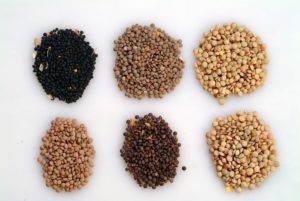Lentils (Lens esculenta and Lens culinaris) are widely cultivated legumes. They are grown and consumed throughout the world, but almost half of the world’s lentils, 45%, are produced in Canada and another 18% in India. The legume is a good source of plant-based protein, fiber, vitamins, and minerals, and is an excellent choice for vegetarians and vegans as a protein-rich alternative to meat. It provides iron, folate, and magnesium; some research suggests it may lower cholesterol levels, provide antioxidants, and reduce the risk of heart disease. At one time it was thought to be a remedy for diphtheria—and also for lovesickness.
Lentils have a rich cultural, religious, and literary history. They were widely cultivated and consumed in ancient Egypt, Greece, and Rome, and remains dating to over 3,000 years ago have been discovered in excavations. They have been found in Egyptian tombs of the twelfth dynasty as food for the dead. In Greek mythology, the god Hermes is said to have been born from a union between the god Zeus and a mortal woman who had been transformed into a cow and had been fed a diet of lentils, which resulted in Hermes’ exceptional strength.
In Genesis, lentils are mentioned as the “pottage of lentils” given to Esau by his brother Jacob in exchange for his birthright. They were also supplied by Shobi the son of Nahash, Makir the son of Ammiel, and Barzillai the Gileadite to David’s forces (2 Sam 17:28), and they were included in the bread mixture that the prophet Ezekiel was commanded to eat for 390 days (Ezek 4:9–10). Lentils are also mentioned several times in the Mishnaic and Talmudic texts.
In Hinduism, lentils are considered a sacred food, often used in religious rituals and offerings. In the traditional Hindu epic the Mahābhārata, the hero Bhima eats lentils to give him the strength to defeat his enemies.
Today, lentils continue to play an important role in culture and cuisine around the world. In present-day India, they are widely eaten as curries with rice, as stuffing in dal parathas and curries, and as flour to prepare papadams. Eaten as dal and hummus also, they are incorporated into a wide range of dishes and products, from vegetarian burgers and sausages to lentil-based pasta and snack bars. They are remembered in pop culture too with the 1969 children’s book The Very Hungry Caterpillar, in which a small caterpillar becomes able, by eating healthy foods, including lentils, to transform into a butterfly.
 |
| Different varieties of lentils. “Lentil” by ICARDA – Science for Resilient Livelihoods in Dry on Flickr. CC BY-NC-ND 2.0. |

Leave a Reply